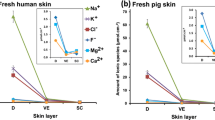Summary
Human autopsy skin was sliced into three sections: an outer epidermis-rich layer, a middle dermis layer, and an inner dermis and subcutaneous fat layer. Each skin slice was bathed in malathion solutions over a 100-fold concentration range of 0.02–3.0 μM/g skin for 48 h at 37° C. Malathion uptake approximated 50% for each skin layer over the total concentration range. Skin capacity for malathion is thus large. Single and double compartment dialysis was used to determine free and bound malathion. Isotherm calculations gave a partition coefficient intercept for epidermis-rich and dermis tissues with aqueous buffer of 2.72 and 2.74, respectively. That of the inner layer of skin was less at 1.70. When malathion was dialyzed against simulated plasma, the binding decreased 2-fold. Since the least partition coefficient (less bound malathion) was in the inner layer of skin, and since malathion has a preference for plasma over water, the two (inner skin and plasma) may combine to create the sink conditions necessary for malathion percutaneous absorption into the body.
Similar content being viewed by others
References
British National Formulary, Number 2 (1981) British Medical Association, The Pharmaceutical Press, London, pp 303–304
Feldmann RJ, Maibach HI (1970) Pesticide percutaneous penetration in man. J Invest Dermatol 54:435–436
Feldmann RJ, Maibach HI (1974) Percutaneous penetration of some pesticides and herbicides in man. Toxicol Appl Pharmacol 28:126–132
Feldmann RJ, Maibach HI (1971) Regional variation in percutaneous penetration in man. Pesticides. Arch Environ Health 23:208–211
Schaefer H, Zesch A, Stüttgen G (1981) Skin permeability in normal and pathologic physiology of the skin. III. Stüttgen G, Spier H, Schwarz E (eds). Springer, Berlin Heidelberg New York, pp 752–753
——, p 674
——, pp 602–603
Windoholz M (ed) (1976) The Merck Index, 9th edn. Merck & Co, Inc, Rahway, NJ, USA, p 5526
Artuc M, Reinhold C, Stüttgen G, J Gazith J (1980) a rapid method for measuring drug enrichment in epidermis. Arch Dermatol Res 268:129–140
Menczel E, Maibach HI (1972) Chemical binding to human epidermis in vitro: testosterone and benzyl alcohol. Acta Derm Venereol (Stockh) 52:38–42
Wahlberg JE (1965) Percutaneous absorption of sodium chromate (51Cr) cobaltous (58Co) and (203Hg) chlorides through excised human and guinea pig skin. Acta Derm Venereol (Stockh) 45:415–426
Wester RC, Maibach HI, Bucks DAW, Guy RH (1983) Malathion percutaneous absorption following repeated administration to man. Toxicol Appl Pharmacol 68:116–119
Allison E (1980) Chronic organophosphate poisoning. S Afr Med J 58:54
Kalow W, Marton S (1961) Second generation toxicity of malathion in rats. Nature 192:464–465
Rusiecki W (1966) Toksykologia srodkow ochrony roslin Warsaw PZWL
Rusiecki W (1964) Zagadnienii toksykologii pestycydow. Zeszyty Problemowe Postepow Nauk Rolniczych 51:11–21
Kimbrough RD, Gaines TB (1968) Effect of organic phosphorous compounds and alkylating agents on the rat fetus. Arch Environ Health 16:805–808
Gill GR, La Ham N (1972) Histochemical and radiographic investigations of malathion-induced malformations in embryonic chick limbs. Can J Zool 50:349–351
Yoder J, Watson M, Benson WW (1973) Lymphocyte chromosome analysis of agricultural workers during extensive occupational exposure to pesticides. Mutat Res 21:335–340
Van Bao T, Szabo J, Rusicska P, Czeizel A (1974) Chromosome aberrations in patients suffering acute organic phosphate insecticide intoxication. Humangenetik 24:33–57
Wild D (1975) Mutagenecity studies on organophosphorus insecticides. Mutat Res 32:133–150
Bedford CT, Robinson J (1972) The alkylation properties of organophosphates. Xenobiotica 2:307–337
Mohn G (1973) 5-Methyltryptophan resistance mutations in Escherichia coli K 12. Mutagenic activity of monofunctional akylating agents including organophosphorus insecticides. Mutat Res 20:7–15
Walter Z, Grabarcyzk M, Kulamowicz I, Olinsky R, Wiaderkiewicz R (1974) The influence of some phosphoric acid esters on DNA structure isolated from rat liver. In: Abstract of the Ninth FEBS Meeting, Budapest, p 411
Olinsky R, Walter Z, Wiaderkiewicz R, Lukasova E, Palecek E (1980) Changes in DNA properties due to treatment with pesticides malathion and DDVP. Radiat Environ Biophys 18:65–72
Walter Z, Czajkowska A, Lipecka R (1980) Effect of malathion on the genetic material of human lymphocytes stimulated by phytohemagglutinin (PHA). Hum Genet 53:375–381
Author information
Authors and Affiliations
Rights and permissions
About this article
Cite this article
Menczel, E., Bucks, D., Maibach, H. et al. Malathion binding to sections of human skin: Skin capacity and isotherm determinations. Arch Dermatol Res 275, 403–406 (1983). https://doi.org/10.1007/BF00417342
Received:
Issue Date:
DOI: https://doi.org/10.1007/BF00417342




